The Influence of Wind-Induced Waves on ENSO Simulations
Abstract
1. Introduction
2. Model and Method
2.1. Model
2.2. Method and Data
3. Influences on ENSO
3.1. Influences on ENSO Properties
3.2. Influences on El Niño and La Niña
3.3. Heat Budget Analysis
4. Conclusions
- (1)
- In both experiments, the simulation of SST suffers from a basin-wide warm bias. The inclusion of the wave model to FIO-ESM 2.0 reduces the warm bias to some extent, particularly in the extratropical region. Differences in the SST between the two experiments have similar spatial distribution to the Bv, with large values in high latitudes and low values in low latitudes. Further analysis demonstrates that the nonbreaking wave-induced vertical mixing influences the SST simulations.
- (2)
- FIO-ESM 2.0 is unable to effectively characterize the two types of El Niño events (i.e., WP El Niño and CT El Niño). Moreover, the impact of waves on ENSO diversity is limited.
- (3)
- The two experiments are able to reproduce the phase locking feature, yet they tend to underestimate the strength of ENSO events. This bias is slightly reduced when the wave model is introduced into FIO-ESM 2.0. The wave model can also improve the ENSO period simulations.
- (4)
- The wave model has little influence on the simulation of the El Niño strength. However, the bias in the simulation of the La Niña amplitude is significantly reduced. Without the wave model, the cooling anomalies are clearly underestimated and restricted around the equator in FIO-ESM 2.0. The inclusion of the wave model increases the maximum amplitude of the cooling anomalies, resulting in values much closer to the observation. In short, the wave model exerts asymmetric influences on El Niño and La Niña events. This can be attributed to the different ocean states. During El Niño events, the thermocline is deep in the east, and thus the wave-induced mixing has little impact on SST anomalies. However, during La Niña events, the thermocline is shallow in the east, which facilitates the upwelling of the cold water to the surface by wave-induced mixing, strengthening the amplitude of La Niña.
- (5)
- Heat budget analysis of the mixed layer revealed that when the wave model is introduced into FIO-ESM 2.0, the vertical, zonal, and meridional advection terms are strengthened. This consequently amplifies the intensity of La Niña and improves simulation accuracy.
Author Contributions
Funding
Institutional Review Board Statement
Informed Consent Statement
Data Availability Statement
Conflicts of Interest
References
- Hasselmann, K. Ocean circulation and climate change. Tellus A 1991, 43, 82–103. [Google Scholar] [CrossRef][Green Version]
- Babanin, A.V.; Ganopolski, A.; Phillips, W.R. Wave-induced upper-ocean mixing in a climate model of intermediate com-plexity. Ocean Model. 2009, 29, 189–197. [Google Scholar] [CrossRef]
- Cavaleri, L.; Foxkemper, B.; Hemer, M.A. Wind Waves in the Coupled Climate System. Bull. Am. Meteorol. Soc. 2012, 93, 1651–1661. [Google Scholar] [CrossRef]
- Craig, P.D.; Banner, M.L. Modeling Wave-Enhanced Turbulence in the Ocean Surface Layer. J. Phys. Oceanogr. 1994, 24, 2546–2559. [Google Scholar] [CrossRef]
- Huang, C.J.; Qiao, F.; Dai, D. Evaluating CMIP5 simulations of mixed layer depth during summer. J. Geophys. Res. Ocean. 2014, 119, 2568–2582. [Google Scholar] [CrossRef]
- Mellor, G.L.; Blumberg, A.F. Wave Breaking and Ocean Surface Layer Thermal Response. J. Phys. Oceanogr. 2004, 34, 693–698. [Google Scholar] [CrossRef]
- Qiao, F.; Song, Z.; Bao, Y.; Song, Y.; Shu, Q.; Huang, C.; Zhao, W. Development and evaluation of an Earth System Model with surface gravity waves. J. Geophys. Res. Ocean. 2013, 118, 4514–4524. [Google Scholar] [CrossRef]
- Wunsch, C.; Ferrari, R. Vertical mixing, energy, and the general circulation of the oceans. Annu. Rev. Fluid Mech. 2004, 36, 281–314. [Google Scholar] [CrossRef]
- Zhao, B.; Qiao, F.; Wang, G. The effects of the non-breaking surface wave-induced vertical mixing on the forecast of tropical cyclone tracks. Chin. Sci. Bull. 2014, 59, 3075–3084. [Google Scholar] [CrossRef]
- Chuanjiang, H.; Fangli, Q.; Zhenya, S. The effect of the wave-induced mixing on the upper ocean temperature in a climate model. Acta Oceanol. Sin. 2008, 27, 104–111. [Google Scholar]
- Song, Z.; Qiao, F.; Song, Y. Response of the equatorial basin-wide SST to non-breaking surface wave-induced mixing in a climate model: An amendment to tropical bias. J. Geophys. Res. Space Phys. 2012, 117. [Google Scholar] [CrossRef]
- Yu, W.; Li, Z.; Yuan, Y. Improvement of the SLP simulation in the coupled AGCM-ocean surface wave model. Chin. Sci. Bull. 2005, 50, 2397–2400. [Google Scholar] [CrossRef]
- Qiao, F.; Huang, C.J. Comparison between vertical shear mixing and surface wave-induced mixing in the extratropical ocean. J. Geophys. Res. Space Phys. 2012, 117. [Google Scholar] [CrossRef]
- Zhao, Y.; Yin, X.; Song, Y.; Qiao, F. Seasonal prediction skills of FIO-ESM for North Pacific sea surface temperature and pre-cipitation. Acta Oceanol. Sin. 2019, 38, 5–12. [Google Scholar] [CrossRef]
- Chen, S.; Qiao, F.; Huang, C.; Song, Z. Effects of the Non-breaking Surface Wave-induced Vertical Mixing on Winter Mixed Layer Depth in Subtropical Regions. J. Geophys. Res. Ocean. 2018, 123, 2934–2944. [Google Scholar] [CrossRef]
- Shu, Q.; Qiao, F.; Song, Z. The hindcast and forecast of sea ice in the Arctic by FIO-ESM based on CMIP5 experiments. In Proceedings of the EGU General Assembly Conference Abstracts, Vienna, Austria, 7–12 April 2013. [Google Scholar]
- Bao, Y.; Song, Z.; Qiao, F. FIO-ESM Version 2.0: Model Description and Evaluation. J. Geophys. Res. Ocean. 2020, 125, 016036. [Google Scholar] [CrossRef]
- Rayner, N.A.; Parker, D.E.; Horton, E.B.; Folland, C.K.; Alexander, L.V.; Rowell, D.P.; Kent, E.C.; Kaplan, A.L. Global analyses of sea surface temperature, sea ice, and night marine air temperature since the late nineteenth century. J. Geophys. Res. Space Phys. 2003, 108, 108. [Google Scholar] [CrossRef]
- Adler, R.F.; Sapiano, M.R.P.; Huffman, G.J.; Wang, J.-J.; Gu, G.; Bolvin, D.; Chiu, L.; Schneider, U.; Becker, A.; Nelkin, E.; et al. The Global Precipitation Climatology Project (GPCP) Monthly Analysis (New Version 2.3) and a Review of 2017 Global Precipitation. Atmosphere 2018, 9, 138. [Google Scholar] [CrossRef]
- Morice, C.P.; Kennedy, J.J.; Rayner, N.A.; Jones, P.D. Quantifying uncertainties in global and regional temperature change using an ensemble of observational estimates: The HadCRUT4 data set. J. Geophys. Res. Atmos. 2012, 117, D8. [Google Scholar] [CrossRef]
- Bjerknes, J. Atmospheric teleconnections from the equatorial Pacific. Mon. Weather Rev. 1969, 97, 163–172. [Google Scholar] [CrossRef]
- Burgers, G.; Stephenson, D.B. The “normality” of el niño. Geophys. Res. Lett. 1999, 26, 1027–1030. [Google Scholar] [CrossRef]
- Jin, F.-F. An equatorial ocean recharge paradigm for ENSO. Part I: Conceptual model. J. Atmos. Sci. 1997, 54, 811–829. [Google Scholar] [CrossRef]
- Kug, J.-S.; Jin, F.-F.; An, S.-I. Two types of El Niño events: Cold tongue El Niño and warm pool El Niño. J. Clim. 2009, 22, 1499–1515. [Google Scholar] [CrossRef]
- Lian, T.; Chen, D.; Tang, Y.; Wu, Q. Effects of westerly wind bursts on El Niño: A new perspective. Geophys. Res. Lett. 2014, 41, 3522–3527. [Google Scholar] [CrossRef]
- Lu, B.; Ren, H.-L. ENSO Features, Dynamics, and Teleconnections to East Asian Climate as Simulated in CAMS-CSM. J. Meteorol. Res. 2019, 33, 46–65. [Google Scholar] [CrossRef]
- Tan, X.; Tang, Y.; Lian, T.; Yao, Z.; Li, X.; Chen, D. A study of the effects of westerly wind bursts on ENSO based on CESM. Clim. Dyn. 2019, 54, 885–899. [Google Scholar] [CrossRef]
- Taylor, K.E.; Stouffer, R.J.; Meehl, G.A. An Overview of CMIP5 and the Experiment Design. Bull. Am. Meteorol. Soc. 2012, 93, 485–498. [Google Scholar] [CrossRef]
- Zhang, T.; Sun, D.-Z. ENSO Asymmetry in CMIP5 Models. J. Clim. 2014, 27, 4070–4093. [Google Scholar] [CrossRef]
- Bellenger, H.; Guilyardi, E.; Leloup, J.; Lengaigne, M.; Vialard, J. ENSO representation in climate models: From CMIP3 to CMIP5. Clim. Dyn. 2014, 42, 1999–2018. [Google Scholar] [CrossRef]
- Ashok, K.; Behera, S.K.; Rao, S.A.; Weng, H.; Yamagat, H.W.A.T. El Niño Modoki and its possible teleconnection. J. Geophys. Res. Space Phys. 2007, 112, 112. [Google Scholar] [CrossRef]
- Kao, H.-Y.; Yu, J.-Y. Contrasting Eastern-Pacific and Central-Pacific Types of ENSO. J. Clim. 2009, 22, 615–632. [Google Scholar] [CrossRef]
- Larkin, N.K.; Harrison, D. On the definition of El Niño and associated seasonal average US weather anomalies. Geophys. Res. Lett. 2005, 32, 13. [Google Scholar] [CrossRef]
- Rasmusson, E.M.; Carpenter, T.H. Variations in tropical sea surface temperature and surface wind fields associated with the Southern Oscillation/El Niño. Mon. Weather Rev. 1982, 110, 354–384. [Google Scholar] [CrossRef]
- Yeh, S.-W.; Kug, J.-S.; An, S.-I. Recent progress on two types of El Niño: Observations, dynamics, and future changes. Asia-Pac. J. Atmos. Sci. 2014, 50, 69–81. [Google Scholar] [CrossRef]
- Ham, Y.-G.; Kug, J.-S. How well do current climate models simulate two types of El Nino? Clim. Dyn. 2012, 39, 383–398. [Google Scholar] [CrossRef]
- Chen, X.; Liao, H.; Lei, X.; Bao, Y.; Song, Z. Analysis of ENSO simulation biases in FIO-ESM version 1.0. Clim. Dyn. 2019, 53, 6933–6946. [Google Scholar] [CrossRef]
- Neale, R.B.; Chen, C.-C.; Gettelman, A.; Lauritzen, P.H.; Park, S.; Williamson, D.L.; Conley, A.J.; Garcia, R.; Kinnison, D.; Lamarque, J.-F. Description of the NCAR community atmosphere model (CAM 5.0). Natl. Cent. Atmos. Res. 2010, 1, 1–12. [Google Scholar]
- Lawrence, D.M.; Oleson, K.W.; Flanner, M.G.; Thornton, P.E.; Swenson, S.C.; Lawrence, P.J.; Zeng, X.; Yang, Z.L.; Levis, S.; Sakaguchi, K. Parameterization improvements and functional and structural advances in version 4 of the Community Land Model. J. Adv. Model. Earth Syst. 2011, 3, 1. [Google Scholar]
- Smith, R.; Jones, P.; Briegleb, B.; Bryan, F.; Danabasoglu, G.; Dennis, J.; Dukowicz, J.; Eden, C.; Fox-Kemper, B.; Gent, P. The parallel ocean program (POP) reference manual ocean component of the community climate system model (CCSM) and community earth system model (CESM). LAUR 2010, 141, 1–140. [Google Scholar]
- Hunke, E.C.; Lipscomb, W.H.; Turner, A.K.; Jeffery, N.; Elliott, S. Cice: The Los Alamos Sea Ice Model Documentation and Software User’s Manual Version 4.1 la-cc-06-012, T-3 Fluid Dynamics Group; Los Alamos National Laboratory: Los Alamos, NM, USA, 2010. [Google Scholar]
- Qiao, F.; Zhao, W.; Yin, X.; Huang, X.; Liu, X.; Shu, Q.; Wang, G.; Song, Z.; Li, X.; Liu, H.; et al. A Highly Effective Global Surface Wave Numerical Simulation with Ultra-High Resolution. In Proceedings of the SC16: International Conference for High Performance Computing, Networking, Storage and Analysis, Salt Lake City, UT, USA, 13–18 November 2016; pp. 46–56. [Google Scholar]
- Carton, J.A.; Giese, B.S. A Reanalysis of Ocean Climate Using Simple Ocean Data Assimilation (SODA). Mon. Weather Rev. 2008, 136, 2999–3017. [Google Scholar] [CrossRef]
- Decremer, D.; Chung, C.E.; Ekman, A.M.; Brandefelt, J. Which significance test performs the best in climate simulations? Tellus A 2014, 66, 23139. [Google Scholar] [CrossRef]
- Zhenya, S.; Fangli, Q.; Yongzeng, Y.; Yeli, Y. An improvement of the too cold tongue in the tropical Pacific with the devel-opment of an ocean-wave-atmosphere coupled numerical model. Prog. Nat. Sci. 2007, 17, 576–583. [Google Scholar] [CrossRef]
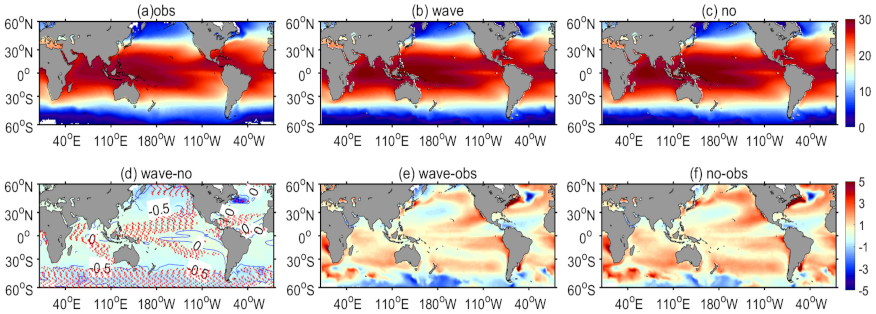
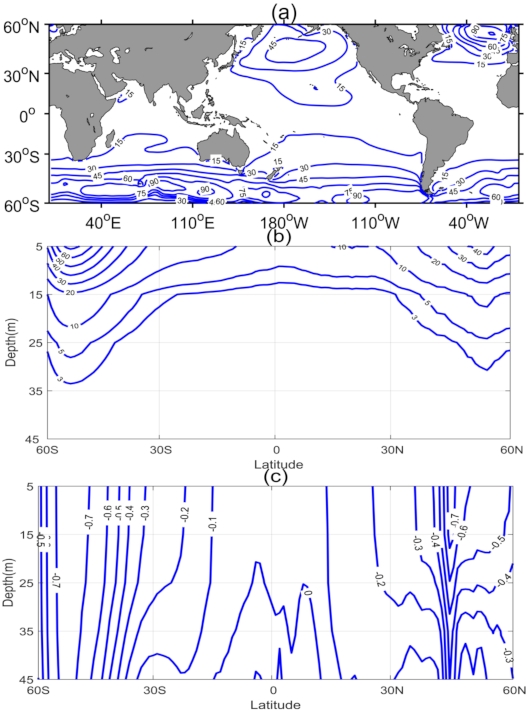
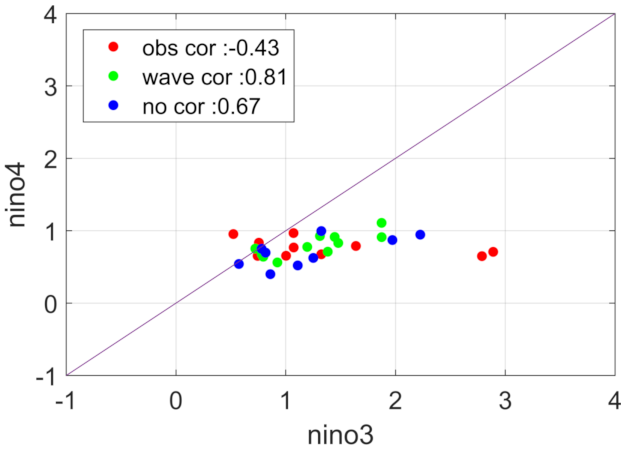
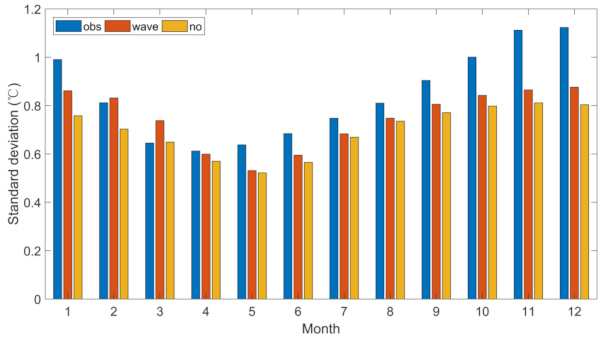
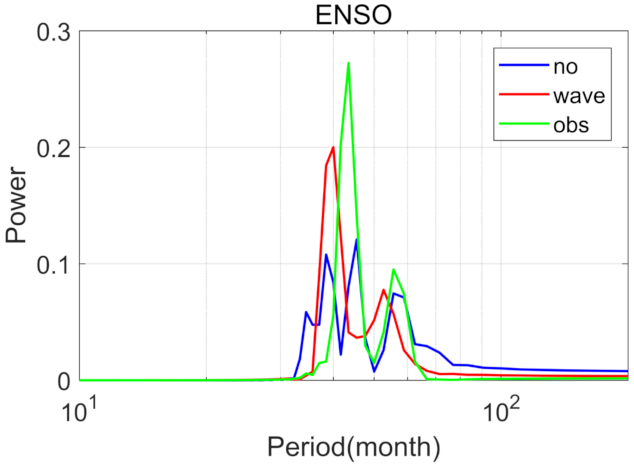
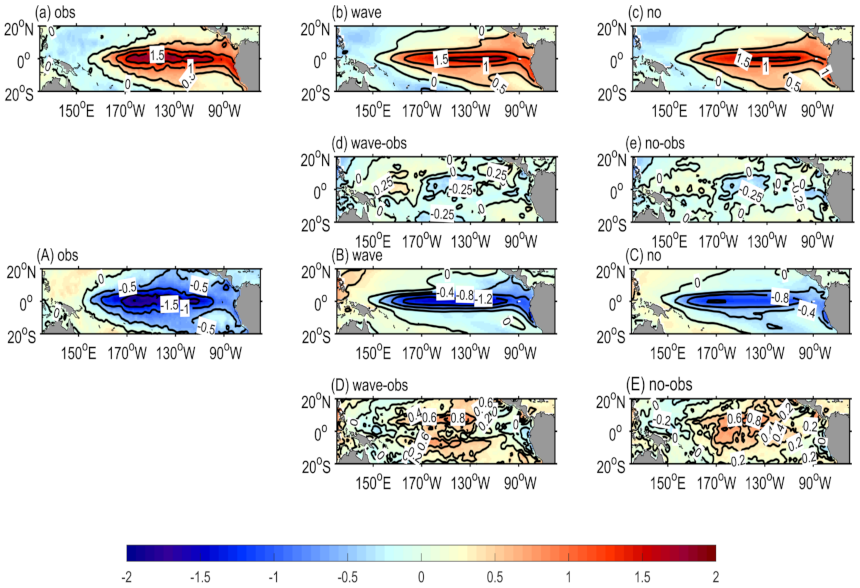
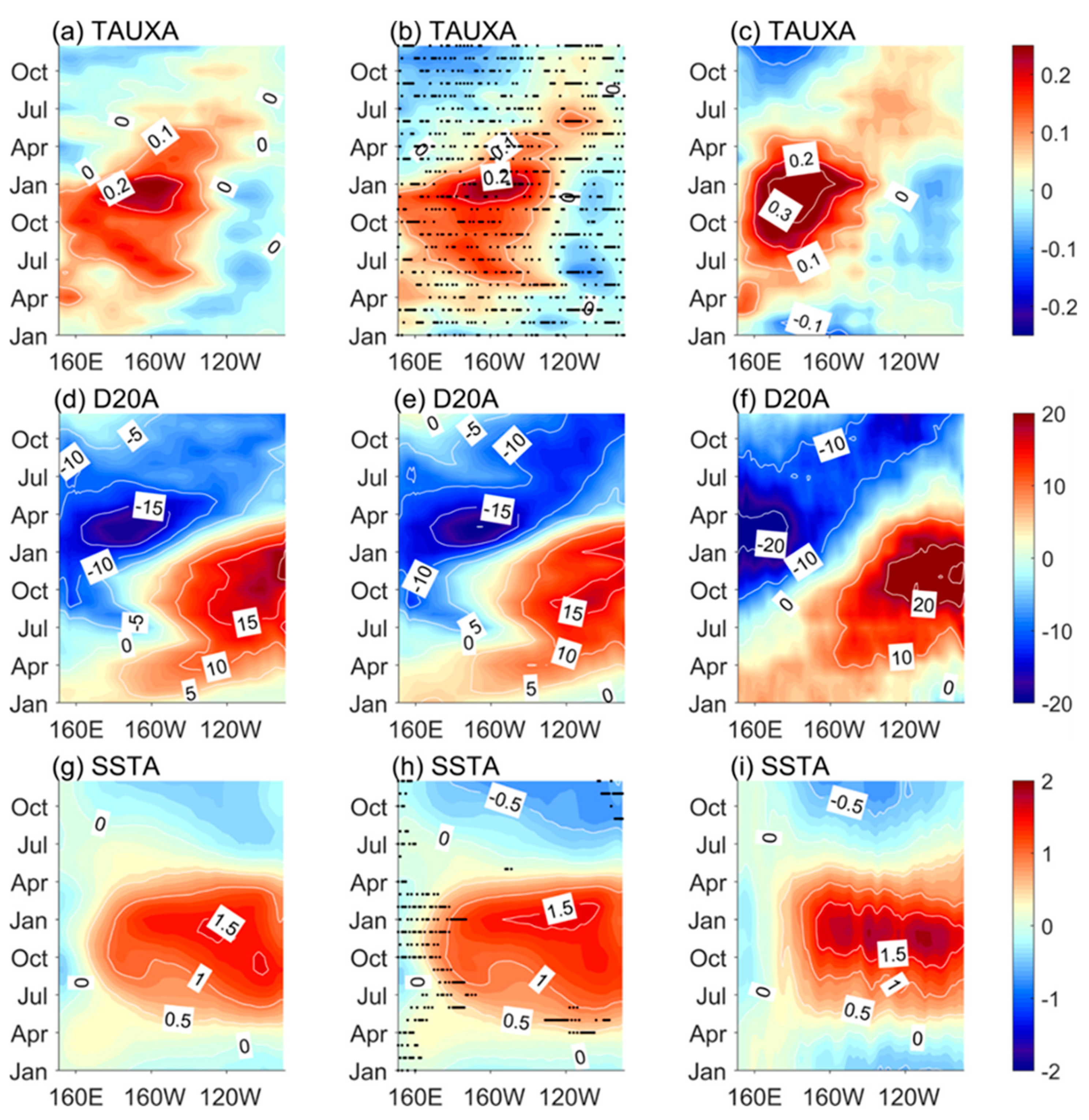
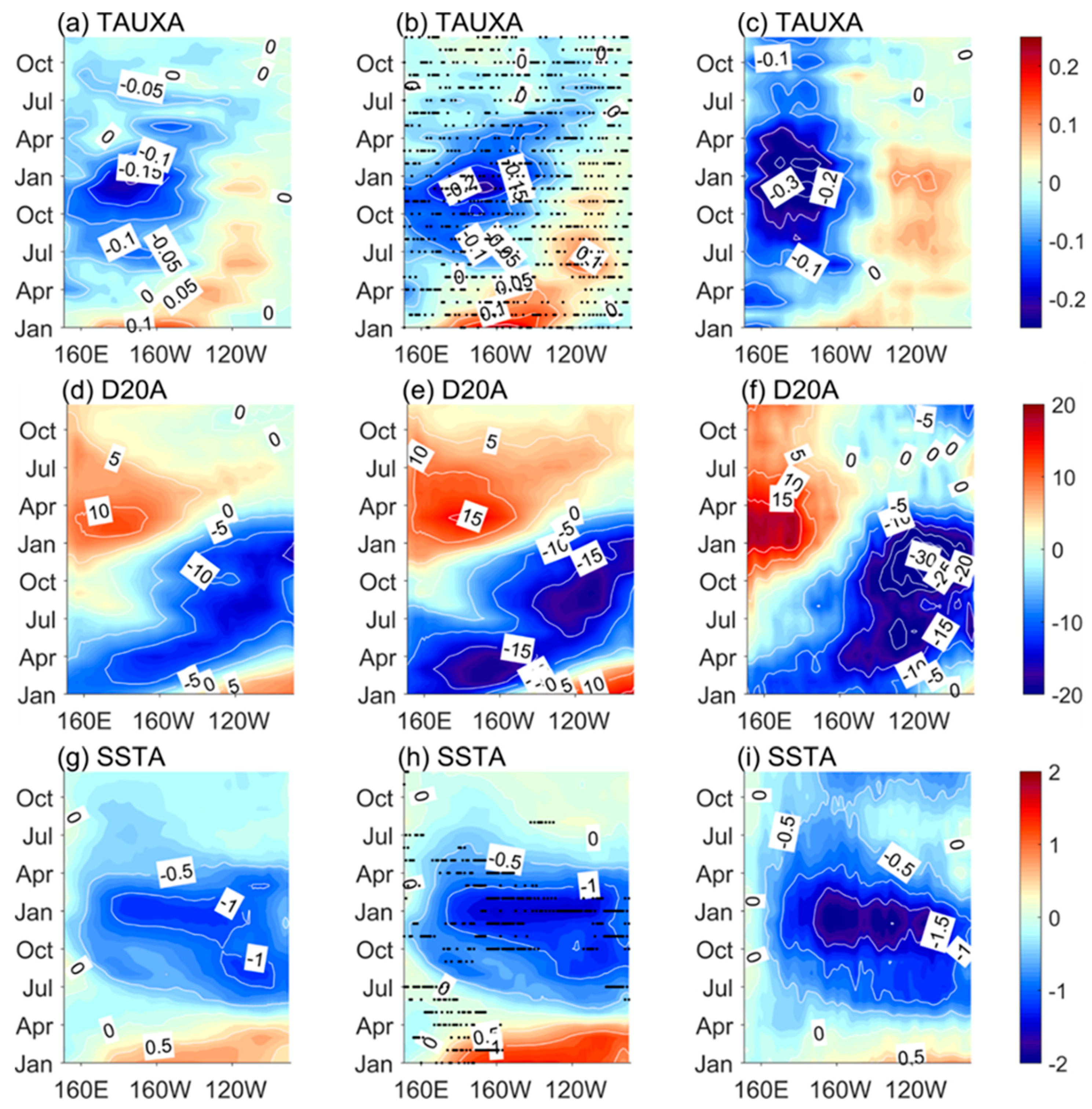

Publisher’s Note: MDPI stays neutral with regard to jurisdictional claims in published maps and institutional affiliations. |
© 2021 by the authors. Licensee MDPI, Basel, Switzerland. This article is an open access article distributed under the terms and conditions of the Creative Commons Attribution (CC BY) license (https://creativecommons.org/licenses/by/4.0/).
Share and Cite
Hu, Y.; Tan, X.; Tang, Y.; Shen, Z.; Bao, Y. The Influence of Wind-Induced Waves on ENSO Simulations. J. Mar. Sci. Eng. 2021, 9, 457. https://doi.org/10.3390/jmse9050457
Hu Y, Tan X, Tang Y, Shen Z, Bao Y. The Influence of Wind-Induced Waves on ENSO Simulations. Journal of Marine Science and Engineering. 2021; 9(5):457. https://doi.org/10.3390/jmse9050457
Chicago/Turabian StyleHu, Yao, Xiaoxiao Tan, Youmin Tang, Zheqi Shen, and Ying Bao. 2021. "The Influence of Wind-Induced Waves on ENSO Simulations" Journal of Marine Science and Engineering 9, no. 5: 457. https://doi.org/10.3390/jmse9050457
APA StyleHu, Y., Tan, X., Tang, Y., Shen, Z., & Bao, Y. (2021). The Influence of Wind-Induced Waves on ENSO Simulations. Journal of Marine Science and Engineering, 9(5), 457. https://doi.org/10.3390/jmse9050457





